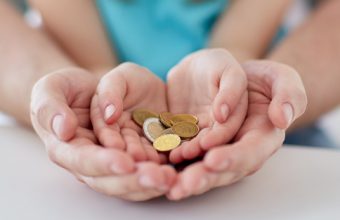Walking down a busy street with my five year-old daughter, we pass a homeless man sitting on the sidewalk with a sign that reads ‘money for food’, and a ball hat with a few loonies and quarters scattered inside.
She tugged on my arm. ‘Mom,’ she said, ‘why doesn’t he just go and press the button at the bank machine? That will give him money for everything he needs.’
That moment was the trigger I needed to teach my child about money. I had worked diligently to teach her to read, to count, to play with others, and about personal hygiene and manners, but neglected to explain that bank machines don’t supply people with an endless supply of cash on demand.
It’s an essential part of life, yet something they don’t learn in school.
I started giving her an allowance, which was good timing because she had recently began asking for things that other kids in her class had that I couldn’t afford. Instead of saying no, and experiencing the unpleasant fallout, I simply told her if it was important to her, she could save her allowance and buy it for herself.
My daughter began with saving for Bratz dolls, progressed to electronics, and currently buys her own clothes. She is now sixteen and works part-time as a hostess at a local restaurant. Between her job and her allowance, she makes her decisions about how she spends the money she earns, so whether she buys expensive name brands or not is up to her, which has saved us from possibly hundreds of arguments over the years.
Receiving a weekly allowance has taught her that some things are worth waiting for, and that needs and wants will constantly change with time, the fashion, and the season. It also put the power of ownership in her own hands—I’ve noticed that she takes better care of the things she’s saved up for with her own money! The sense of independence and the delayed gratification that comes from saving are all part of the financial education I’m trying my best to give her.
While I like to think I am the best teacher for my child when it comes to life and learning, it helps to have back up. Talk With Our Kids About Money (TWOKAM) is a free program powered by BMO Financial Group in partnership with the Canadian Foundation for Economic Education that helps parents relay financial information to their children in an age appropriate manner. Whether you need to brush up your financial know-how before talking to your bigger kids, or need a guiding hand breaking things down into kid-friendly stories and concepts, the site is like a toolbox for parents looking to increase their kids’ financial literacy. Most importantly, it has the backing of BMO, so the information is current, sound, and meaningful to real families. Plus, since the content is developed by educators you can trust that you are getting age-appropriate content.
Their home program has all sorts of resources for kids of any age—we love that you can sort the resources according to how old your kids are, so you only see the info that applies to you. You’ll find everything from advice on walking your big kid through opening their first bank account, to how to talk to little kids about money using familiar things like Aladdin. (Money can’t buy happiness, right Jasmine?) The site is full of practical tips and advice—and there are even curriculum-aligned lesson plans for teachers, too.
After perusing the Talk With Our Kids About Money site I realized I shouldn’t be only talking to my daughter about her financial choices—I talk to her now about my own. Like many things in life, open and transparent dialogue is a healthy way to learn about life choices. Whether I make a mistake buying expensive oranges at the grocery store or a stock I bought last year is at a 52-week high and I’m deciding whether to hold or sell it, both situations make the dinner table agenda these days. I want her to learn that talking about money shouldn’t be taboo, so that she’ll grow up confident enough to ask the right questions and take charge of her finances. I’m doing what I can to start her down that road of financial literacy now.
She’s come a long way from the five year-old who thought money came at the push of a button, and I’m happy that I’ve taught her that lesson myself. April 20 is Talk With Our Kids About Money Day. If you don’t already give your kids an allowance, it’s a good day to start, and a good day to begin that conversation.
This post is brought to you by BMO, main partner of Talk With Our Kids About Money, but the images and opinions are those of SavvyMom.ca.
Tagged under: kids,Parenting,advice,Money,finances,bmo,Talk With Our Kids About Money
Category: family-finance






